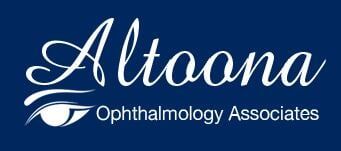Eye Care in Altoona, PA
At Altoona Ophthalmology Associates,
our eye care professionals have the experience and skill to help preserve your optical health with a wide range of eye disease testing and examinations.
State-of-the-Art Technology
With high-tech equipment such as our Optical Coherence Tomography (OCT), we are able to screen for a number of diseases including age-related macular degeneration and retinal abnormalities. Certain procedures are done in-office, but cataract surgeries are performed at the Altoona Regional Health System Surgery Center, found adjacent to the Altoona Hospital.

Eye Care in Altoona, PA
At Altoona Ophthalmology Associates,
our eye care professionals have the experience and skill to help preserve your optical health with a wide range of eye disease testing and examinations.
State-of-the-Art Technology
With high-tech equipment such as our Optical Coherence Tomography (OCT), we are able to screen for a number of diseases including age-related macular degeneration and retinal abnormalities. Certain procedures are done in-office, but cataract surgeries are performed at the Altoona Regional Health System Surgery Center, found adjacent to the Altoona Hospital.

Our practice features a full-service optical staff specializing in cataracts, glaucoma, diabetic eye care, pediatric eye surgery and more including:
- Eye Disease Testing
- Eye Allergy Management
- Cataract Management
- Cataract Surgery
- Posterior Capsulotomy
- Macular Degeneration
- Diabetic Retinopathy
- Strabismus
- Amblyopia
- Glaucoma Management
- Diabetic Eye Care
- Pediatric Eye Surgery
Eye Disease Facts
Cataract Surgery
What is cataract surgery?
Cataract surgery is a type of surgery used to remove the lens of your eye when it is cloudy. Your lens should be clear to see but with a cataract, your eye's ability to bend light is affected and this affects your vision. With a cataract, your vision is blurry, hazy or less colorful. With cataract surgery, your natural cloudy lens is removed and replaced with a clear, synthetic lens. We call this lens an intraocular lens (IOL). At Altoona Ophthalmology Associates, our doctors will discuss IOLs and how they work.
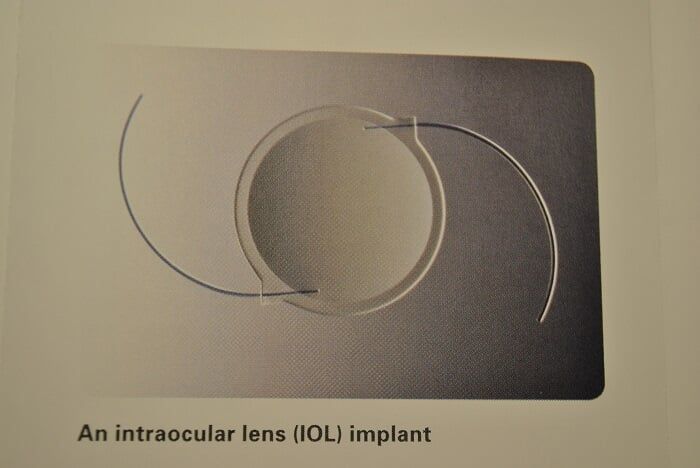
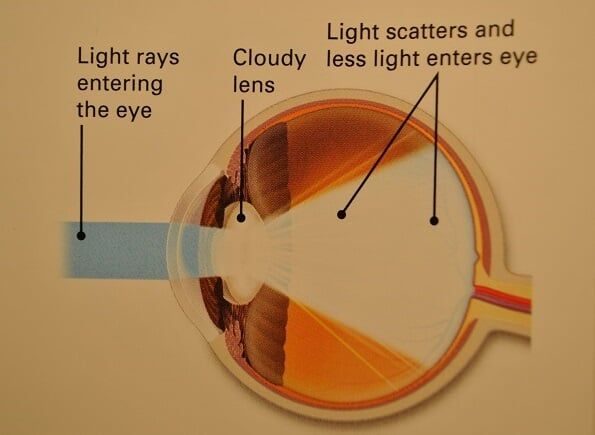
Our practice features a full-service optical staff specializing in cataracts, glaucoma, diabetic eye care, pediatric eye surgery and more including:
- Eye Disease Testing
- Eye Allergy Management
- Cataract Management
- Cataract Surgery
- Posterior Capsulotomy
- Macular Degeneration
- Diabetic Retinopathy
- Strabismus
- Amblyopia
- Glaucoma Management
- Diabetic Eye Care
- Pediatric Eye Surgery
Eye Disease Facts
Cataract Surgery
What is cataract surgery?
Cataract surgery is a type of surgery used to remove the lens of your eye when it is cloudy. Your lens should be clear to see but with a cataract, your eye's ability to bend light is affected and this affects your vision. With a cataract, your vision is blurry, hazy or less colorful. With cataract surgery, your natural cloudy lens is removed and replaced with a clear, synthetic lens. We call this lens an intraocular lens (IOL). At Altoona Ophthalmology Associates, our doctors will discuss IOLs and how they work.


Our practice features a full-service optical staff specializing in cataracts, glaucoma, diabetic eye care, pediatric eye surgery and more including:
- Eye Disease Testing
- Eye Allergy Management
- Cataract Management
- Cataract Surgery
- Posterior Capsulotomy
- Macular Degeneration
- Diabetic Retinopathy
- Strabismus
- Amblyopia
- Glaucoma Management
- Diabetic Eye Care
- Pediatric Eye Surgery
Eye Disease Facts
Cataract Surgery
What is cataract surgery?
Cataract surgery is a type of surgery used to remove the lens of your eye when it is cloudy. Your lens should be clear to see but with a cataract, your eye's ability to bend light is affected and this affects your vision. With a cataract, your vision is blurry, hazy or less colorful. With cataract surgery, your natural cloudy lens is removed and replaced with a clear, synthetic lens. We call this lens an intraocular lens (IOL). At Altoona Ophthalmology Associates, our doctors will discuss IOLs and how they work.


GLAUCOMA
What is glaucoma?
What is glaucoma?
Glaucoma is a disease affecting the optic nerve which helps carry images to the brain. Blind spots develop when optic nerve fibers are damaged. These blind spots can go undetected for some time until the optic nerve is severely damaged. Blindness results if the entire nerve is damaged.
Detecting glaucoma early and getting treatment by your ophthalmologist is the key to preventing more optic nerve damage and blindness. Early detection and treatment can prevent loss of sight. The leading cause of blindness, especially in older people, is glaucoma.

What causes glaucoma?
The cause of glaucoma is a clear liquid called aqueous humor which
circulates inside the front of the eye.
A small amount of this liquid is normal to maintain a healthy level of
pressure within the eye. An equal amount
of this liquid also flows out of the eye through a drainage system. If the drainage area for the aqueous
humor (also called the drainage
angle) is blocked, the excess fluid cannot flow out of the eye causing pressure
to increase. This pressure increase causes damage to the optic nerve. How is glaucoma detected?
The best way to detect glaucoma is to have regular eye examinations by your ophthalmologist. It is highly recommended to have a complete eye exam as a glaucoma screening only checks the pressure of the eye.
Posterior Capsulotomy
What is Posterior capsulotomy?
Posterior capsulotomy is a surgical procedure that sometimes follows eye surgery.
What is Posterior capsulotomy?
Posterior capsulotomy is a surgical procedure that sometimes follows eye surgery.
It is necessary because cataract surgery removes the cataract from the lens capsule. An artificial lens needs to replace that lens. The artificial lens is called the intraocular lens or IOL. It is inserted to replace the natural lens.
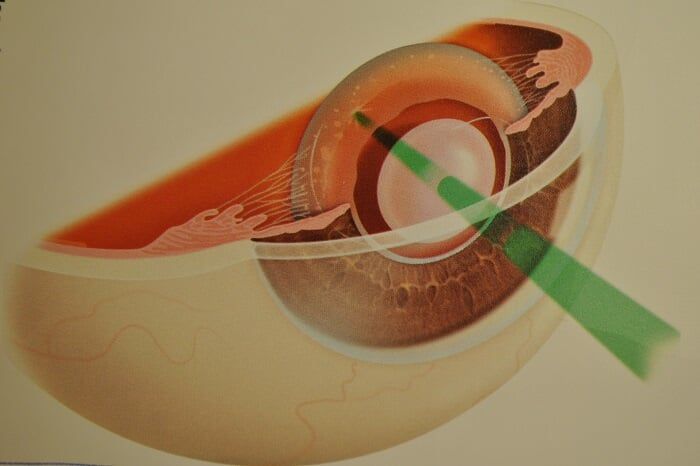
Weeks to years after cataract surgery, the capsule may become cloudy or wrinkled and cause blurred vision. A posterior capsulotomy is a simple laser procedure that makes an opening in the back, or posterior, part of the capsule to restore your normal vision.
GLAUCOMA
What is glaucoma?
What is glaucoma?
Glaucoma is a disease affecting the optic nerve which helps carry images to the brain. Blind spots develop when optic nerve fibers are damaged. These blind spots can go undetected for some time until the optic nerve is severely damaged. Blindness results if the entire nerve is damaged.
Detecting glaucoma early and getting treatment by your ophthalmologist is the key to preventing more optic nerve damage and blindness. Early detection and treatment can prevent loss of sight. The leading cause of blindness, especially in older people, is glaucoma.

What causes glaucoma?
The cause of glaucoma is a clear liquid called aqueous humor which
circulates inside the front of the eye.
A small amount of this liquid is normal to maintain a healthy level of
pressure within the eye. An equal amount
of this liquid also flows out of the eye through a drainage system. If the drainage area for the aqueous
humor (also called the drainage
angle) is blocked, the excess fluid cannot flow out of the eye causing pressure
to increase. This pressure increase causes damage to the optic nerve. How is glaucoma detected?
The best way to detect glaucoma is to have regular eye examinations by your ophthalmologist. It is highly recommended to have a complete eye exam as a glaucoma screening only checks the pressure of the eye.
Posterior Capsulotomy
What is Posterior capsulotomy?
Posterior capsulotomy is a surgical procedure that sometimes follows eye surgery.
What is Posterior capsulotomy?
Posterior capsulotomy is a surgical procedure that sometimes follows eye surgery.
It is necessary because cataract surgery removes the cataract from the lens capsule. An artificial lens needs to replace that lens. The artificial lens is called the intraocular lens or IOL. It is inserted to replace the natural lens.

Weeks to years after cataract surgery, the capsule may become cloudy or wrinkled and cause blurred vision. A posterior capsulotomy is a simple laser procedure that makes an opening in the back, or posterior, part of the capsule to restore your normal vision.
Macular Degeneration
What is macular degeneration?
Macular degeneration is a disease that affects the "macula" which is found in the retina. What the macula does for your vision is help you see fine details more clearly and do things like reading or driving. If you have central vision that is blurry or areas that are dark, your macula may be affected. Also, if you have difficulty seeing near and far and things like ready or threading a needle are challenging, you should be tested for macular degeneration.What is macular degeneration?
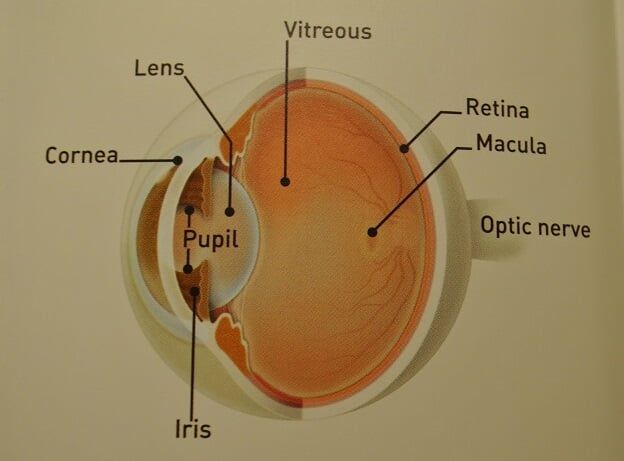
Macular degeneration
reduces vision in the central part of the retina but not usually the eye's side
(peripheral) vision. So, seeing things like the outline of a picture frame but
not the actual picture is an example of this disease. Macular degeneration will
not cause blindness on its own.
Even in the most advanced cases, there will still be useful vision and people can live their normal lives. Some cases of macular degeneration will only affect a small portion of your vision but in others, vision loss can be quick and serious. In people over 50, Macular degeneration is the most common cause of vision loss.
DRY MACULAR DEGENERATION
Almost ninety percent of patients with AMD, have the “dry” form. This results in thinning of macular tissue and is caused by (oxidative stress). With this form, vision loss is usually gradual and people have difficulties adjusting to light changes. Adjusting to light changes, like outside to inside, may take some time.
WET MACULAR DEGENERATION
The wet form of AMD affects ten percent of patients. This form can often cause significant vision loss. This is caused when abnormal blood vessels form underneath the retina and leak fluid or blood. This leakage will result in blurred vision and vision loss.
Even in the most advanced cases, there will still be useful vision and people can live their normal lives. Some cases of macular degeneration will only affect a small portion of your vision but in others, vision loss can be quick and serious. In people over 50, Macular degeneration is the most common cause of vision loss.
DRY MACULAR DEGENERATION
Almost ninety percent of patients with AMD, have the “dry” form. This results in thinning of macular tissue and is caused by (oxidative stress). With this form, vision loss is usually gradual and people have difficulties adjusting to light changes. Adjusting to light changes, like outside to inside, may take some time.
WET MACULAR DEGENERATION
The wet form of AMD affects ten percent of patients. This form can often cause significant vision loss. This is caused when abnormal blood vessels form underneath the retina and leak fluid or blood. This leakage will result in blurred vision and vision loss.
Macular Degeneration
What is macular degeneration?
Macular degeneration is a disease that affects the "macula" which is found in the retina. What the macula does for your vision is help you see fine details more clearly and do things like reading or driving. If you have central vision that is blurry or areas that are dark, your macula may be affected. Also, if you have difficulty seeing near and far and things like ready or threading a needle are challenging, you should be tested for macular degeneration.What is macular degeneration?

Macular degeneration
reduces vision in the central part of the retina but not usually the eye's side
(peripheral) vision. So, seeing things like the outline of a picture frame but
not the actual picture is an example of this disease. Macular degeneration will
not cause blindness on its own.
Even in the most advanced cases, there will still be useful vision and people can live their normal lives. Some cases of macular degeneration will only affect a small portion of your vision but in others, vision loss can be quick and serious. In people over 50, Macular degeneration is the most common cause of vision loss.
DRY MACULAR DEGENERATION
Almost ninety percent of patients with AMD, have the “dry” form. This results in thinning of macular tissue and is caused by (oxidative stress). With this form, vision loss is usually gradual and people have difficulties adjusting to light changes. Adjusting to light changes, like outside to inside, may take some time.
WET MACULAR DEGENERATION
The wet form of AMD affects ten percent of patients. This form can often cause significant vision loss. This is caused when abnormal blood vessels form underneath the retina and leak fluid or blood. This leakage will result in blurred vision and vision loss.
Even in the most advanced cases, there will still be useful vision and people can live their normal lives. Some cases of macular degeneration will only affect a small portion of your vision but in others, vision loss can be quick and serious. In people over 50, Macular degeneration is the most common cause of vision loss.
DRY MACULAR DEGENERATION
Almost ninety percent of patients with AMD, have the “dry” form. This results in thinning of macular tissue and is caused by (oxidative stress). With this form, vision loss is usually gradual and people have difficulties adjusting to light changes. Adjusting to light changes, like outside to inside, may take some time.
WET MACULAR DEGENERATION
The wet form of AMD affects ten percent of patients. This form can often cause significant vision loss. This is caused when abnormal blood vessels form underneath the retina and leak fluid or blood. This leakage will result in blurred vision and vision loss.
Diabetic Retinopathy
Diabetes can affect your sight
The two types of diabetic retinopathy are called nonproliferative diabetic retinopathy (NPDR)
and proliferative diabetic retinopathy (PDR). Background retinopathy or NPDR is an early
stage of retinopathy. Tiny blood vessels within the retina leak blood or fluid
during this stage. The leaking fluid caused deposits called “exudates”. Mild NPDR (which affects many diabetes
patients) does not affect vision. When
the vision is affected, it's due to macular edema, macular is chemiaor both
diseases. Diabetes can affect your sight
With Macular edema, the patient will experience swelling or thickening of the macula which is a small part of the center of the retina. This part of the retina allows us to see fine details clearly. The most common cause of vision loss in people with diabetes is from the swelling and leaking of fluid. Vision loss can be mild or severe. However, even in the worse forms, peripheral vision is still functional.
When small blood vessels (capillaries) close, this is called Macular ischemia. Because the macula doesn't receive sufficient blood supply, vision can become blurry.
PDR can be detected when abnormal new vessels (neovascularization) grow on the surface of the retina. The widespread closure of retinal blood vessels is the main cause of PDR. In response to the closure of vessels, the retina grows new blood vessels. Unfortunately, the new abnormal vessels don't function properly and are often accompanied with scar tissue. The scar tissue can cause wrinkling or even detachment of the retina.
PDR is more serious than NPDR because it can cause severe vision loss and affects both central and peripheral vision.
We help diagnose and treat your eye condition. Call our office today! 814-946-0821
